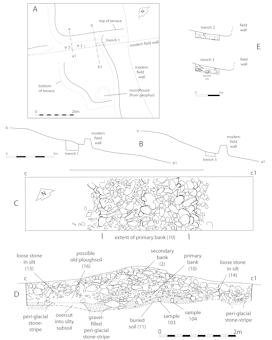
A trench, 6m by 1.4m in area, was excavated across one of the early cross-contour boundaries (Figure 4, Trench 1). This was shown to be preserved below, and thus predate, a substantial early contour field terrace, c.2m high. It was protected from later cultivation by a post-medieval wall (Figure 6). The time available did not allow excavation of the terrace above.

The bank consisted of a low spread of sub-angular stones, about 0.8m high and 3.4m wide, within which were the remains of a stony 'core' c.2.6m wide (Figure 6C and 6D). This had no deliberately laid wall or bank facing although a number of slightly larger stones had been placed, somewhat irregularly, to provide rough external edges on both sides. Beneath the spread of 'tumble' (15), on the west side of the bank was a fairly deep, humic stony loam (16), which was probably the ploughsoil contemporary with the boundary. The wide spread of stones suggested that the bank had been added to with clearance stones unsystematically over time and there was no clear evidence that the bank had ever been a wall, although the possible effects of animal trampling make that uncertain.
Below the stony core was found a low 'primary bank' of orange silt (10), 0.25m high, which was, perhaps, just a marking-out bank. Below the primary bank was a buried soil (11), a grey-brown friable silt with a few small stones and occasional flecks of charcoal. This appeared to be a relict topsoil pre-dating the field system. The subsoil beneath the buried soil was light to mid-grey silt with angular rock fragments, interrupted in places by gravel-filled linear features, possibly periglacial ice wedges.
Two small soil test pits (Figure 6E) were also excavated to the north-west of the main trench, in a narrow space between the contour terrace and the modern field wall and thus unlikely to have been affected by post-medieval cultivation and possibly an unchanged relict soil of the last use of the terraced field system. The shallow topsoil appeared to be a mixed, cultivated soil and was sampled for soil micromorphological study.
Internet Archaeology is an open access journal based in the Department of Archaeology, University of York. Except where otherwise noted, content from this work may be used under the terms of the Creative Commons Attribution 3.0 (CC BY) Unported licence, which permits unrestricted use, distribution, and reproduction in any medium, provided that attribution to the author(s), the title of the work, the Internet Archaeology journal and the relevant URL/DOI are given.
Terms and Conditions | Legal Statements | Privacy Policy | Cookies Policy | Citing Internet Archaeology
Internet Archaeology content is preserved for the long term with the Archaeology Data Service. Help sustain and support open access publication by donating to our Open Access Archaeology Fund.